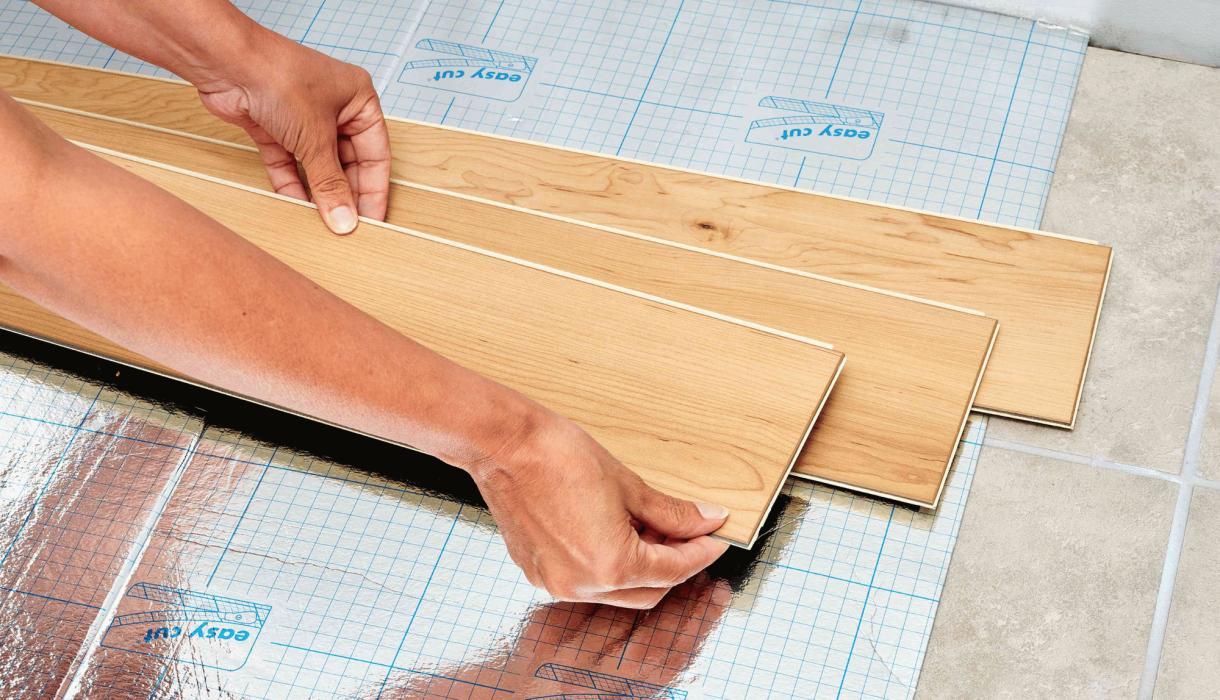Updating your flooring can instantly transform a space, but the thought of removing existing tiles might seem daunting. Many homeowners ask us, “Can you lay vinyl flooring over tiles?” The short answer is yes – in many cases, it’s entirely possible to install vinyl flooring directly over existing tile, saving you time, money, and mess. But there’s more to consider than simply rolling out new flooring on top of old.
At Abernethy Bespoke Flooring, we’ve helped countless customers across Wigan and the North West upgrade their tired tile floors with stylish vinyl alternatives. This guide provides everything you need to know about this popular flooring solution.
Determining If Your Tiled Floor Is Suitable for Vinyl Overlay
Not all tiled floors make appropriate bases for vinyl installation. Before proceeding, you’ll need to carefully assess your existing floor.
Evaluating Tile Condition
First, inspect your tiles thoroughly. Press down firmly on various areas of the floor – do you notice any movement or hollow sounds? Loose or cracked tiles need addressing before installing new flooring. Small hairline cracks might be okay, but larger damage requires repair or replacement.
Check the grout lines too. Severely deteriorated grout might indicate underlying issues with the subfloor that should be fixed first. Minor grout damage is typically fine as long as the tiles themselves remain stable.
Checking Floor Levelness
Vinyl flooring demands a relatively flat surface to prevent premature wear and visible imperfections. Run your hand across the floor – can you feel significant lippage (height differences) between tiles? Use a long straight edge to identify dips or humps greater than 3mm over a 1-metre span.
Highly textured tiles present challenges too. Deep relief patterns or heavily embossed surfaces might telegraph through thin vinyl products, creating an uneven appearance. These situations require additional prep work or choosing thicker vinyl products.
Key Benefits of Installing Vinyl Over Tiles
There are several compelling reasons to choose vinyl overlay rather than complete tile removal.
Significant Time and Cost Savings
Removing ceramic or porcelain tiles is notoriously difficult, time-consuming, and messy. The process typically involves breaking tiles with heavy equipment, creating dust and debris throughout your home. By skipping this step, you’ll save considerable money on labour costs and waste disposal fees.
Many homeowners find they can complete a vinyl-over-tile installation in a single weekend, versus the week or more required for complete tile removal and replacement. This makes it an excellent option for quick home updates or rental property renovations.
Minimal Disruption to Your Household
Living through a traditional floor replacement can severely disrupt daily life. Furniture must be removed, dust barriers installed, and areas of your home might become completely unusable during demolition.
Installing vinyl over tiles greatly reduces this disruption. There’s minimal dust, no heavy demolition noise, and the process can often be completed room by room, allowing you to maintain some normalcy during your renovation.
Additional Insulation Benefits
Many homeowners report their floors feel warmer and more comfortable after installing vinyl over tiles. The additional layer provides extra thermal insulation, particularly beneficial for tiled floors installed directly over concrete slabs. This can make a noticeable difference in comfort during colder months.
Professional Tips for Preparing Tiled Floors
Proper preparation is absolutely critical for successful vinyl-over-tile installation. Skimping on these steps almost guarantees disappointing results.
Thorough Cleaning Requirements
Start with a deep clean of your existing tile. Years of foot traffic, cleaning products, and environmental factors create residue that can prevent proper adhesion. We recommend:
- Sweeping and vacuuming to remove loose debris
- Scrubbing with a mild degreasing cleaner to remove built-up residue
- Paying special attention to grout lines, which often harbour hidden dirt
- Rinsing thoroughly and allowing the floor to dry completely
For particularly dirty or greasy floors (common in kitchens), you might need multiple cleaning sessions or specialised degreasers. The goal is a completely clean, residue-free surface.
Addressing Grout Lines Effectively
Grout lines present the biggest challenge when installing vinyl over tiles. Without proper preparation, these recessed lines can eventually “telegraph” through your vinyl, creating visible lines that mirror the pattern of your old tile floor.
For narrow, shallow grout lines (2mm or less), quality vinyl with good backing might bridge these gaps effectively. Wider or deeper grout requires filling with a suitable floor levelling compound. Apply the compound with a flat trowel, working it firmly into the grout lines while keeping it level with the tile surface.
After the compound dries, sand any high spots to create a completely smooth surface. This step takes time but drastically improves your final results.
Fixing Damaged Areas
Address any floor problems before proceeding with vinyl installation:
- Secure loose tiles using appropriate adhesive
- Replace severely damaged tiles
- Repair major cracks or chips with epoxy filler
- Ensure the floor is structurally sound
Professional Floor Preparation services can handle these repairs if you’re unsure about tackling them yourself.
Choosing the Right Vinyl Type for Tile Overlay
Not all vinyl flooring products perform equally well when installed over tiles. Your selection should be guided by your specific situation.
Sheet Vinyl Considerations
Traditional sheet vinyl comes in large rolls and can be an economical choice for tile overlay projects. However, it has specific limitations:
Sheet vinyl works best over extremely well-prepared tile floors with minimal imperfections. Because it’s relatively thin and flexible, it conforms to the underlying surface – including any remaining grout lines or imperfections.
Choose products with cushioned backing, which provides additional thickness and helps mask minor surface irregularities. Quality sheet vinyl typically ranges from 2mm to 4mm thick; opt for the thicker end of this spectrum when installing over tiles.
Professional installation is highly recommended for sheet vinyl, as proper measurement, cutting, and adhesion require experience. Our Vinyl Flooring specialists can ensure a flawless finish.
Luxury Vinyl Tile and Plank Options
LVT Floor Fitting products have revolutionised the flooring industry and offer excellent solutions for installing over tile:
Luxury vinyl planks and tiles provide substantially more rigidity than sheet vinyl, helping them bridge minor imperfections in the underlying tile. Many feature click-lock edges that create floating floors, eliminating the need for full-surface adhesive.
These products typically range from 4mm to 8mm thick, with thicker options providing better coverage over imperfections. Some include integrated underlayment layers, adding cushioning and smoothing capabilities.
The wider variety of authentic-looking wood and stone designs makes luxury vinyl particularly popular for major style transformations. Moving from dated ceramic tile to modern wood-look vinyl can completely reinvent a space.
Speciality Products for Challenging Situations
For particularly problematic tile floors, consider specialised vinyl products:
- Extra-rigid SPC (Stone Polymer Composite) vinyl provides superior bridging over uneven surfaces
- Vinyl with attached cork underlayment offers enhanced sound dampening and irregularity masking
- Contract-grade vinyl with fibreglass reinforcement adds dimensional stability in fluctuating environments
These premium options cost more initially but can save money in the long run by reducing preparation requirements and extending the life of your installation.
Step-by-Step Installation Guide
The specific installation process depends on your chosen vinyl type, but these general guidelines apply to most situations.
Essential Tools and Materials
Gather everything you’ll need before starting:
- Measuring tape and straight edge
- Sharp utility knife with spare blades
- Notched trowel (for adhesive applications)
- Hard roller (for pressing down vinyl)
- Appropriate adhesive (if required)
- Levelling compound and trowel
- Sandpaper and sanding block
- Cleaning supplies
Having the right tools ready prevents delays and frustration during installation.
Installation Process Variations
For sheet vinyl:
- Take precise measurements, adding extra for trimming
- Cut your vinyl sheet slightly oversized
- Position carefully in the room
- Trim edges precisely using a sharp knife
- Apply adhesive if required by the manufacturer
- Roll thoroughly to remove air bubbles and ensure proper bonding
For luxury vinyl planks/tiles:
- Acclimate the flooring in your home for at least 24 hours
- Start laying from the centre of the room or according to manufacturer guidelines
- Use appropriate spacers for expansion gaps
- Cut end pieces with a sharp knife, scoring first then snapping
- Tap pieces together firmly (for click systems)
- Install trim and transition pieces last
For Herringbone Flooring patterns, precise measurement and layout are particularly important. These distinctive patterns require careful planning but create stunning results.
Special Considerations for Different Room Types
Different spaces present unique challenges when installing vinyl over tiles.
Bathroom Installations
Bathrooms require special attention due to moisture exposure:
- Select vinyl products specifically rated for wet areas
- Consider fully adhering the vinyl rather than floating installation
- Pay careful attention to sealing edges around toilets, bathtubs, and shower areas
- Use waterproof silicone caulk where the vinyl meets fixtures or walls
- Ensure no water can penetrate beneath the vinyl to prevent mould and mildew
The added moisture protection of vinyl makes it excellent for updating dated bathroom tile, but proper installation is essential to prevent water damage.
Kitchen Applications
Kitchens present different challenges:
- Choose vinyl with high wear resistance for this heavily-used area
- Consider how the new floor height will affect appliance fit
- Pay special attention to transitions at doorways
- Allow for expansion around fixed cabinetry
- Use appropriate protection under heavy appliances
A well-installed vinyl floor can dramatically update a kitchen without the disruption of removing existing tile.
Common Mistakes to Avoid
Even experienced DIYers sometimes make these errors when installing vinyl over tile:
Inadequate Surface Preparation
The most common mistake is rushing through or skipping proper surface preparation. Every hour spent preparing the tile surface saves days of frustration with your new vinyl floor. Don’t cut corners on cleaning, filling grout lines, or addressing imperfections.
Ignoring Manufacturer Guidelines
Different vinyl products have specific installation requirements. Some need full adhesive coverage, while others are designed to float. Some require specific underlayments, while others prohibit them. Always read and follow the manufacturer’s instructions precisely.
Overlooking Expansion Requirements
Vinyl flooring expands and contracts with temperature changes. Failing to leave appropriate expansion gaps around the perimeter can cause buckling or edge lifting. Always follow the manufacturer’s specifications for expansion space.
When to Call Professional Installers
While DIY installation is possible for many homeowners, certain situations warrant professional help:
- Complex room layouts with numerous obstacles or challenging cuts
- Severely uneven tile floors requiring extensive preparation
- Large spaces where precise installation affects long-term performance
- When manufacturer warranties require professional installation
Professional installers bring specialized tools, knowledge, and experience that ensure optimal results. For quality installation in Wigan and surrounding areas, contact our team at 07495 424721 or email michaelabernethy@live.co.uk to discuss your project.
Maintenance and Care for Your New Vinyl Floor
To keep your new vinyl floor looking its best:
- Clean regularly with a pH-neutral cleaner made for vinyl flooring
- Avoid harsh chemicals, abrasive cleaners, or steam mops
- Wipe up spills promptly to prevent slipping and staining
- Use felt pads under furniture to prevent scratches and dents
- Place mats at entrances to reduce dirt tracking
- Lift rather than drag heavy furniture when moving
With proper care, quality vinyl flooring installed over tiles can last 10-20 years, providing excellent return on your investment.
Final Thoughts
Can you lay vinyl flooring over tiles? Absolutely – with proper preparation, appropriate materials, and careful installation, it’s an excellent way to transform your space without the mess and expense of tile removal.
This approach offers a practical solution for homeowners seeking to update their flooring quickly and economically. By following the guidance in this article, you can achieve professional-looking results that enhance your home’s beauty and functionality.
If you’re considering this option for your Wigan or North West property, our experienced team at Abernethy Bespoke Flooring is ready to help with expert advice, quality products, and professional installation services. Contact us today to discuss how we can transform your tiled floors into beautiful, modern vinyl surfaces you’ll love.


